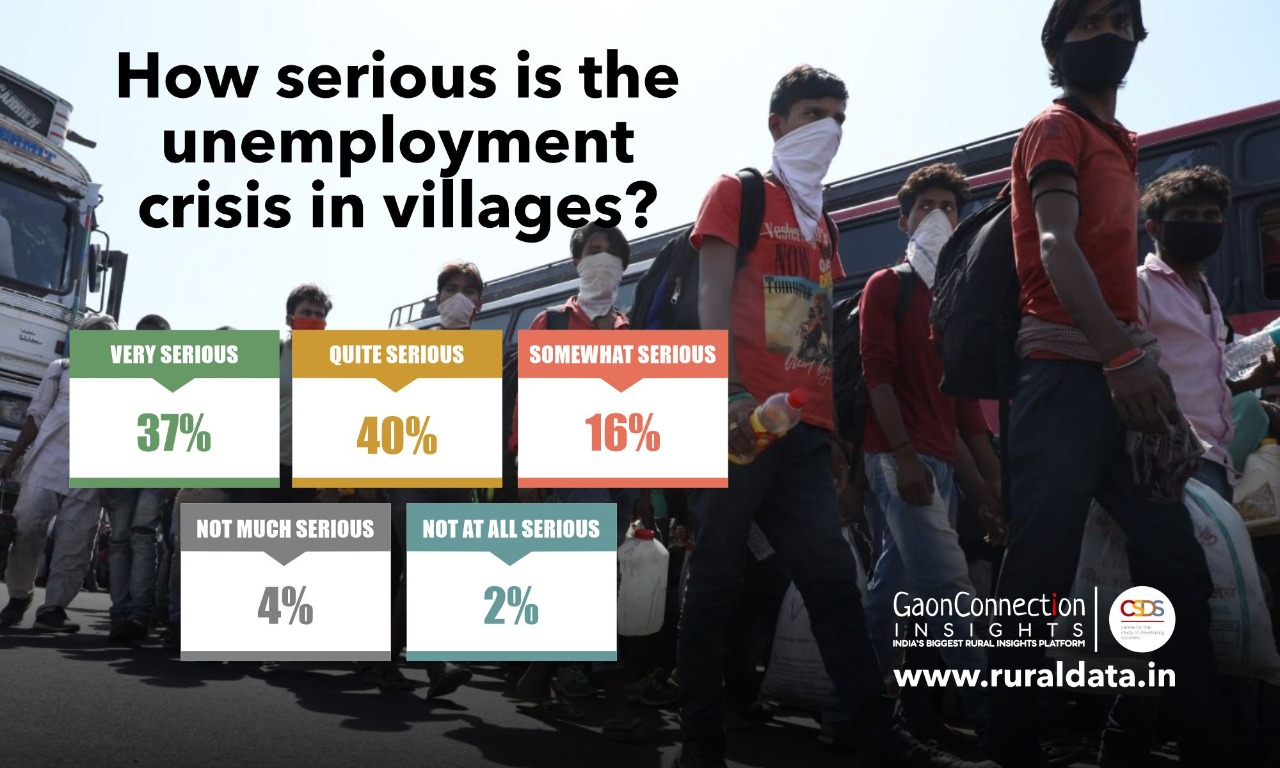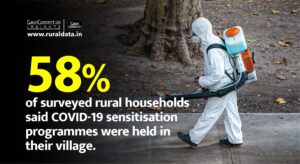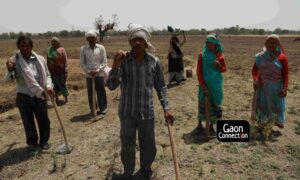Shyamlal Pramanik from Burdwan district in West Bengal used to work in Mumbai. After being stranded in the metropolis, jobless for a month during the lockdown, he managed to reach his village. Initial relief soon gave way to confusion, as he does not know what to do.
“There is no job for me in the village whereas my company in Mumbai has begun its operations. It seems that I may have to head back to the city again,” Pramanik told Gaon Connection.
Unprecedented COVID19-led reverse migration has wreaked havoc in the lives of millions of men and women who now face unemployment and despair back in their villages. Many, who had thought the government would provide help, are hugely disappointed.
India’s largest rural media institution Gaon Connection conducted a survey among 25,000 villages and found that about 93 per cent of the villagers said unemployment, which had been a major problem in their village or area, had aggravated due to the lockdown. While 37 per cent of the respondents considered this problem to be very serious, 40 per cent thought it was serious and 16 per cent felt it was somewhat serious.
Most of the migrants who returned back to their villages were now in a quandary.
Dilip Kumar Mahato of Kothi village in Bokaro district of Jharkhand rented a motorcycle from Mumbai to reach his village in May. But after a month, he was forced to return to Mumbai as he was unable to find any job in the village. “I have four daughters and I am the lone breadwinner, so I cannot afford to sit idle for long. I too am afraid of coronavirus, but then I have other responsibilities,” he said.
Nusserat, a widow with a young child, from Nawada district in Bihar worked as a daily wage worker and domestic help in Nawada and adjoining areas earlier but since the lockdown she has no job. Thousands like Nusserat have lost their jobs including Vicky Kumar Arya of Almora (Uttarakhand), Kailash Pathak of Dewas (Madhya Pradesh), Umesh Sharma of Ghazipur (Uttar Pradesh), Rakesh Kumar Manhade of Baloda Bazar (Chhattisgarh), Jagdish Kaur of Moga (Punjab), Mohammad Riaz of Hazratbal (Jammu and Kashmir) and Anita Barik of Bolangir (Odisha), due to the COVID19-led lockdown and find it hard to meet their day to day expenses.
Gaon Connection conducted the survey across 179 districts of 20 states and three union territories to take stock of the situation arising out of the COVID19 lockdown. The survey was conducted between May 30 and July 16, 2020 in which 25,371 people took part and shared their challenges arising out of the lockdown.
The problem of unemployment is more serious for the poor and lower middle class and is slightly less for the middle and richer sections. Even in the latter categories, more than 90 per cent of the people saw unemployment as a very big problem, the survey said.
The COVID19 lockdown brought on the second largest reverse migration post independence in the country and more than one crore people returned to their villages from metros like Delhi, Mumbai, Surat and Chennai. The country’s chief labour commissioner had said the migration had involved about 26 lakh migrant labourers. While the Solicitor General of India had told the Supreme Court that about 97 lakh migrant labourers had returned during the lockdown. The researchers, who studied the migration pegged the number between 2 crores and 2.2 crores. As per The Economic Survey, 2017, the total number of migrant labourers across the country was more than 6 crores that had come out of rural India to cities in search of a livelihood.
In the Gaon Connection survey, out of the 25,000 respondents, about 1,000 were migrant labourers. Of these 28 per cent had said they would look for job opportunities in their villages and districts and not go back to big cities. Fifteen per cent are still confused whether to go back.
Thirty three per cent of the people said they would have to return to metros to support their families while 8 per cent said they would go explore for jobs in a new city. 16 per cent did not respond.
The survey found that migrant labourers who had returned from other states were more committed to going back, whereas the people who worked in big cities in their state did not wish to leave their homes and villages anymore. In the respective graph you can see the supporting figures
During the migration, several state governments had talked about conducting skill mapping of the returnees to provide them employment locally. Uttar Pradesh, Bihar, Jharkhand, Madhya Pradesh, Maharashtra and Uttarakhand had expressed the intent to do so at the time.
“I had thought that we would be taken care of by the government once we reached home but am disappointed to find no one really bothered about us. I had to come back to Punjab, where I earn decent wages during the paddy season which will be followed by the wheat crop. With the two crops, I would have earned enough to support my entire family expenses for the full year,” Baijnath of Gonda district in Uttar Pradesh, who is an agricultural labourer at a large farm in Punjab, said.
In Gaon Connection survey, 62 per cent of the people cited the lack of means of employment in their villages and districts behind their migration to cities while 19 per cent said that they went to big cities to earn good money or wages. 16 per cent people had migrated to cities to look for better opportunities or better lifestyles.
“During the lockdown, I had returned from Gandhinagar in Gujarat. Although work is found here, the wages were very low. As against the rate of Rs 400 a day in the city, we get only Rs. 190 here. So, as soon as the situation becomes alright, I will head back to Gandhinagar to our contractor,” Gal Singh Bhuria, a migrant labourer from Devjhiri in Madhya Pradesh said. Dinesh Kumar Yadav, a labourer from Motihari district of Bihar, too said he would return to Haryana where was paid Rs.4600 per acre for paddy cultivation besides other facilities.
Migrant labourers who did not wish to leave their villages looked on farming as the biggest option for employment. In the Gaon Connection survey, about 37 per cent of the people they would do farming in their village.
24 per cent of the people said they would not go back to the city but would look around locally to find similar work as they had no farming land while 8 per cent, who had some money saved wanted to start their own work. 11 per cent of the respondents believed MGNREGS as the biggest option for their employment.
However, the survey revealed that 80 per cent of the villagers admitted of not being given any work in MGNREGS during the lockdown.
Economist DM Diwakar told Gaon Connection that of the returnees, those who had not been able to learn any skill or those who did not have farming land or capital, would suffer the most and may be forced to go back to the cities for work. He said it was the state government’s responsibility to employ the labourers who had learnt some skills to minimize migration of labour.
However, senior economic journalist Arvind Singh said, rural India had less employment resources and opportunities. He said “the government would have to prepare a detailed roadmap to create employment at the local level.The workers should be allowed to leave for work and the government should arrange trains or buses for them as done previously for their arrival.”
The real picture
3 out of 5 people (60%) admitted the lack of employment in villages to be the reason behind migration to cities
Every fifth person or 19% of the people admitted to have moved to the cities for better wages
28% of the people said that they would have to head back to the city to support their families
33% of the people will not go back to big cities to earn
37% of the people will stay back in the villages doing farming
80% said they did not get any work under MGNREGS
56% of the returnees were less that 35 years of age.
The survey methodology
The national survey was conducted by India’s largest rural media institution, Gaon Connection, to learn about the impact of lockdown on rural life, in consultation with the public policy programme of the Centre for the Study of Developing Societies (CSDS), the country’s premier research institution in Delhi. The survey was conducted across 179 districts of 20 states and 3 union territories of the country. The states where the survey was conducted included Rajasthan, Punjab, Haryana, Himachal Pradesh, Uttarakhand, Bihar, Uttar Pradesh, Jharkhand, West Bengal, Sikkim, Assam, Arunachal Pradesh, Manipur, Tripura, Odisha, Kerala, Maharashtra, Gujarat, Madhya Pradesh and Chandigarh, besides, the survey was also conducted in Jammu and Kashmir, Ladakh, Andaman and Nicobar Islands. In the survey, the main breadwinner of the house was interviewed and a separate survey was conducted among the lockdown returnees that were 963 in number.
Out of the total respondents, 79.1 per cent were men and 20.1 per cent were women. 53.7 per cent of those surveyed were between 26 and 45 years old. Of these, 33.1 per cent were either illiterate or only educated below primary level, 15 per cent were graduates. The surveyed 43 per cent people were poor, 24.9 per cent lower class and 25 per cent of the respondents had belonged to the middle income group.
The entire survey was taken up by the surveyors of Gaon Connection with the helpof smartphones through the Face to Face app. During the entire survey, the COVID guidelines (masks, proper distance, hand sanitizer) etc. were strictly adhered to.
Neelesh Mishra, founder of Gaon Connection, while releasing the survey had added, “In this hour of corona crisis, rural India was not a part of the mainstream national media agenda. The survey is a strong document which explains how rural India has so far borne the crisis and what is its future course of action viz., whether the migrant labour would head back to cities or whether they have altered their spending patterns to be better equipped for such crisis and avoiding economic hardships thereby.”
“Based on the diversity, breadth and sample size of the survey, I can definitely say that this is the first comprehensive survey of its kind, which focuses on the impact of lockdown on rural India,” asserted Sanjay Kumar, the professor at CSDS, New Delhi.
“In the entire survey, where the respondents are 100 per cent i.e., 25,000, the probability sampling method has been used and 95 per cent of the locations are likely to have a possible error of only +/ – 1 percent. Because a certain and proportional numbers of samples have not been taken from all states and union territories according to their population, non-predictability sampling method has been used in many logistic and COVID related issues and in such cases, we are not in a position to calculate the possible error,” Sanjay Kumar further affirmed.



















